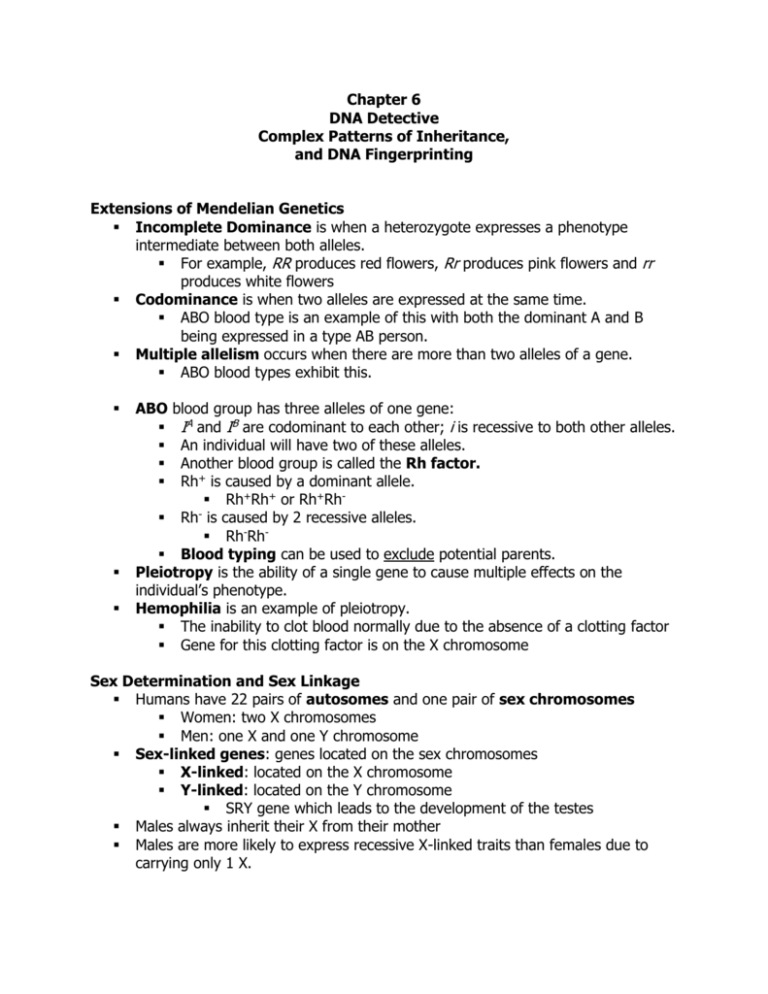Ch 6 Notes
advertisement

Chapter 6 DNA Detective Complex Patterns of Inheritance, and DNA Fingerprinting Extensions of Mendelian Genetics Incomplete Dominance is when a heterozygote expresses a phenotype intermediate between both alleles. For example, RR produces red flowers, Rr produces pink flowers and rr produces white flowers Codominance is when two alleles are expressed at the same time. ABO blood type is an example of this with both the dominant A and B being expressed in a type AB person. Multiple allelism occurs when there are more than two alleles of a gene. ABO blood types exhibit this. ABO blood group has three alleles of one gene: IA and IB are codominant to each other; i is recessive to both other alleles. An individual will have two of these alleles. Another blood group is called the Rh factor. Rh+ is caused by a dominant allele. Rh+Rh+ or Rh+Rh Rh- is caused by 2 recessive alleles. Rh-Rh Blood typing can be used to exclude potential parents. Pleiotropy is the ability of a single gene to cause multiple effects on the individual’s phenotype. Hemophilia is an example of pleiotropy. The inability to clot blood normally due to the absence of a clotting factor Gene for this clotting factor is on the X chromosome Sex Determination and Sex Linkage Humans have 22 pairs of autosomes and one pair of sex chromosomes Women: two X chromosomes Men: one X and one Y chromosome Sex-linked genes: genes located on the sex chromosomes X-linked: located on the X chromosome Y-linked: located on the Y chromosome SRY gene which leads to the development of the testes Males always inherit their X from their mother Males are more likely to express recessive X-linked traits than females due to carrying only 1 X. Females are less likely to express X-linked traits since they have to have 2 copies of the bad X’s. Only females can be carriers of X-linked recessive traits. Carriers express the normal trait but are heterozygous, so they carry the allele for the recessive trait. Hemophilia, red-green color blindness, and Duchenne Muscular dystrophy are example of X-linked traits. X inactivation guarantees that all females receive only 1 dose of the proteins by the X chromosomes. Inactivation is irreversible and inherited during cell division. It is caused by RNA wrapping around the X chromosome. Pedigrees Pedigree: a family tree, showing the inheritance of traits through several generations Symbols commonly used in pedigrees are circles and squares Pedigrees reveal modes of inheritance Pedigree for an autosomal dominant trait: DNA Fingerprinting No two individuals are genetically identical except for identical twins. Small differences in nucleotide sequences of their DNA This is the basis for DNA fingerprinting Unambiguous identification of people When sample size is small it is necessary to copy the genetic material to increase the quantity available for testing. Small amounts of DNA can be amplified using PCR (polymerase chain reaction) DNA is mixed with nucleotides, specific primers, Taq polymerase, and then is heated Heating splits the DNA molecules into two complementary strands Taq polymerase builds a new complementary strand DNA is heated again, splitting the DNA and starting a new cycle. DNA is cut into fragments using restriction enzymes, which cut around DNA sequences called VNTRs (variable number tandem repeats). Gel electrophoresis separates DNA fragments on basis of their sizes Electric current is applied to an agarose gel Smaller fragments run faster through the gel Fragments are transferred to a sheet of filter paper Labeled probe reveals locations of fragments containing VNTRs Each person’s set of fragments is unique. All of a child’s bands must be present in one or both of the parents. To see if parents and their children were Romanovs, DNA fingerprints were prepared for relatives of tsar and tsarina. Adult male skeleton (related to the children) was related to George, the tsar’s brother. Adult female skeleton (related to the children) was related to Prince Philip, the tsarina’s grand-nephew. Conclusion: the grave contained the tsar, tsarina, three of their children, and four servants.






